Do you want to use the WordPress desktop app for your self-hosted WordPress.org blog?
The WordPress desktop app allows you to easily write and edit blog posts without being distracted by other browser tabs.
In this article, we will show you how to use the WordPress desktop app for your self-hosted WordPress blog.
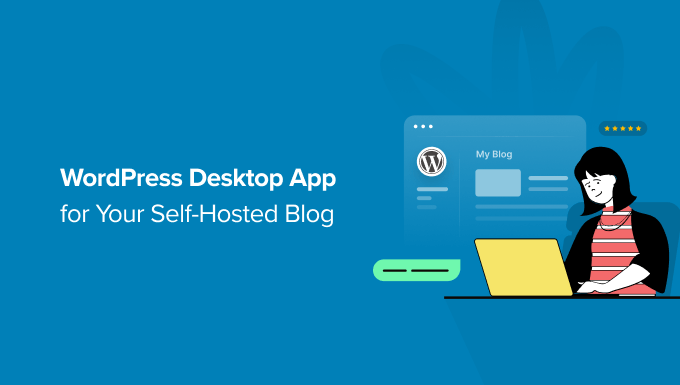
Why Use the WordPress Desktop App? (Pros & Cons)
The WordPress desktop app was created by Automattic, the company founded by WordPress co-founder Matt Mullenweg. It is also the company behind Jetpack and WordPress.com. For details, you can see our article on the comparison between WordPress.com vs. WordPress.org.
The WordPress desktop app offers an improved user experience for self-hosted WordPress websites, which is particularly great for users who are looking for a distraction-free editor to create content.
However, just like everything else in the world, it has its own pros and cons.
Pros
- It offers a nice user interface to manage your website.
- It syncs your content fast and offers a great writing experience.
- The app offers a distraction-free writing area to create your content.
- It allows you to perform website management tasks without opening your browser, like updating plugins and answering comments.
Cons
- It doesn’t work while offline. This means you cannot write posts and just save them to your computer using the desktop app.
- It requires you to install the Jetpack plugin and sign up for a WordPress.com account.
That being said, let’s take a look at how to use the WordPress desktop app for your self-hosted WordPress.org site.
Using WordPress Desktop App for Self-Hosted WordPress
The first thing you need to do is install and activate the Jetpack plugin on your website. For more details, see our step-by-step guide on how to install a WordPress plugin.
For this tutorial, we will use the Jetpack free version. Jetpack also offers premium plans to get started.
Upon activation, you can go to will be asked to connect Jetpack to a WordPress.com account.
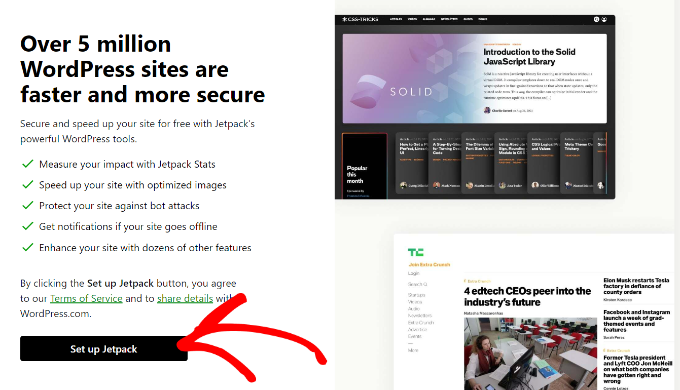
You need to click on the ‘Set up Jetpack’ button to continue.
This will take you to the WordPress.com website. If you already have a WordPress.com account, then you can log in and click the ‘Approve’ button.
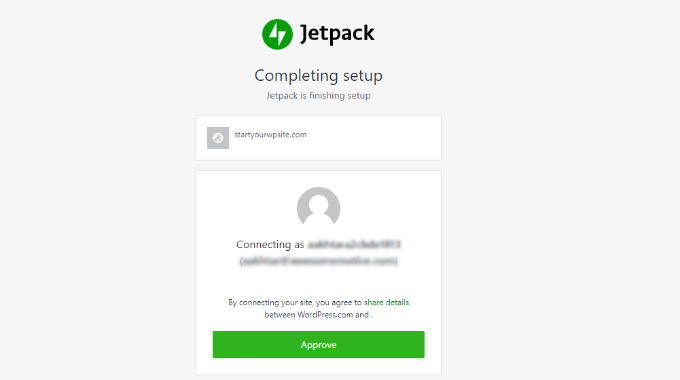
Alternatively, you can create a new account.
After signing in, you will be taken to the pricing page. Simply scroll down to the bottom of the page and click the ‘Start with Jetpack Free’ button.
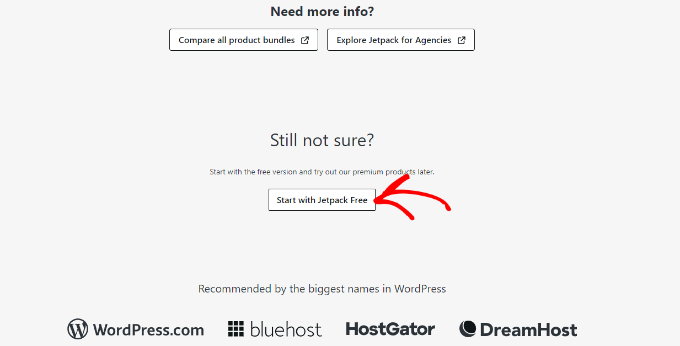
WordPress.com will now create your free account, and you will be redirected back to your website.
Installing the WordPress Desktop App
Next, you need to download and install the WordPress Desktop App on your computer.
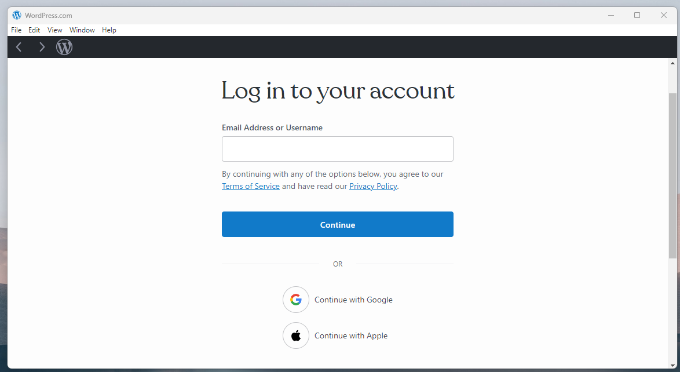
After installation, go ahead and launch the app. Here, you will see the login screen where you need to enter your WordPress.com username and password to log in.
Once logged in, you will see the WordPress.com reader screen, where you can explore content and follow blogs. To manage your website, you will need to switch to the ‘My Sites’ tab.
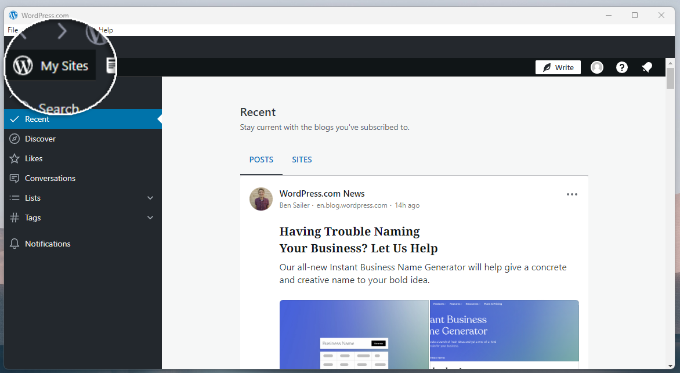
You will now see your website title in the left menu, along with other website management sections. In the right column, you will see Jetpack traffic reports.
Creating a New Post in the WordPress Desktop App
Using the admin bar on the left column, you can edit and create posts, pages, and custom post types. You can also add a new blog post by clicking on the ‘Write’ button at the top.
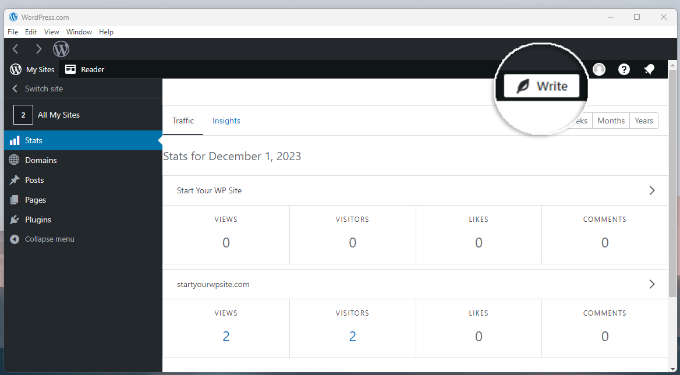
When you click the button, you might see different websites associated with your account.
Go ahead and select your website.
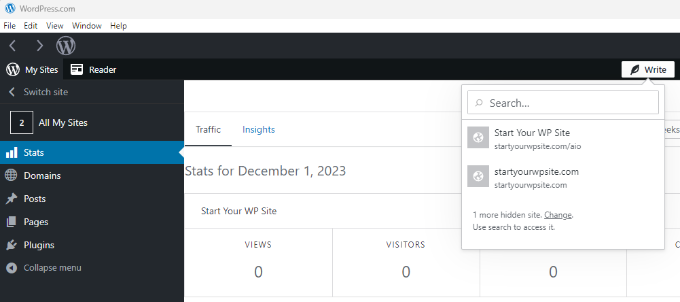
From here, simply log in to your website.
After that, the content editing area offers a very polished user experience. It basically mirrors your WordPress site in the desktop app.
You get to experience the block editor but on your desktop screen.
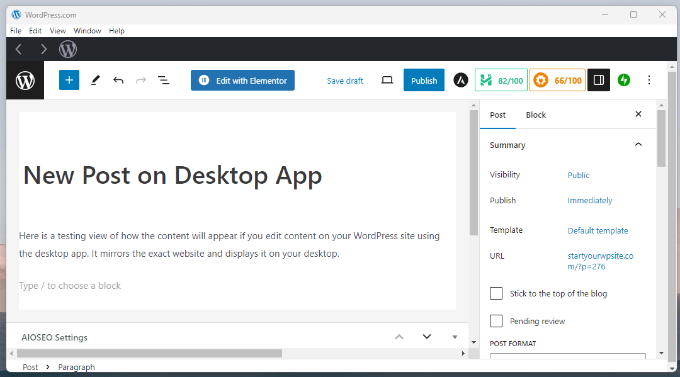
Managing WordPress Themes in the Desktop App
Next, you can also view the WordPress admin panel in the desktop app.
For instance, you can go to ‘Appearance’ and manage themes installed on your website. You can also install a new theme without leaving the app.
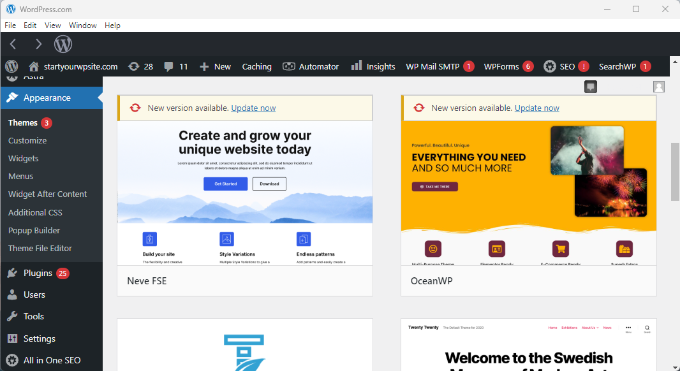
If you click the ‘Customize’ button, then it will open the Theme Customizer or the Full Site Editor, depending on the theme you are using.
Managing Plugins from the WordPress Desktop App
The ‘Plugins section allows you to install, upload, and activate plugins directly from the app.
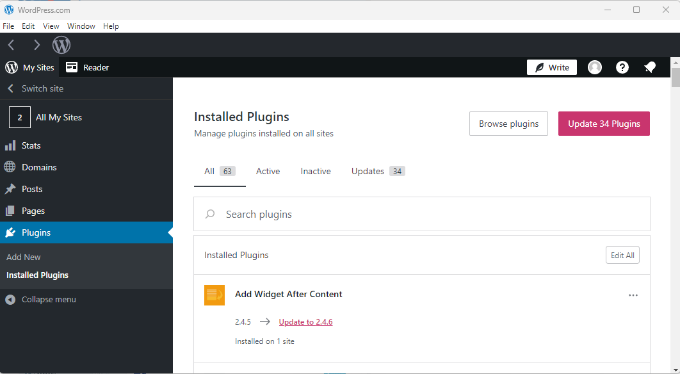
The app will also notify you of plugin updates, and you can update them directly from the app.
You can also optionally auto-update plugins that you trust.
View Posts and Pages from the Desktop App
Next, you can view all the pages and posts on your site from the desktop app by going to ‘Posts’ or ‘Pages’.
There are options to edit, view, look at stats, and trash the posts and pages.
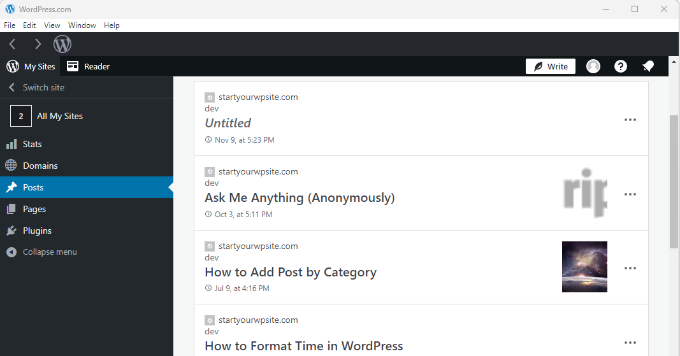
Adding New Websites to the Desktop App
If you manage multiple WordPress sites, then you can add them to the app and manage them from the same dashboard.
Any new website you want to work on should have Jetpack installed and be connected to the same WordPress.com account you are using in your app. After that, you can simply click on the ‘Add new site’ button in the app to add them.
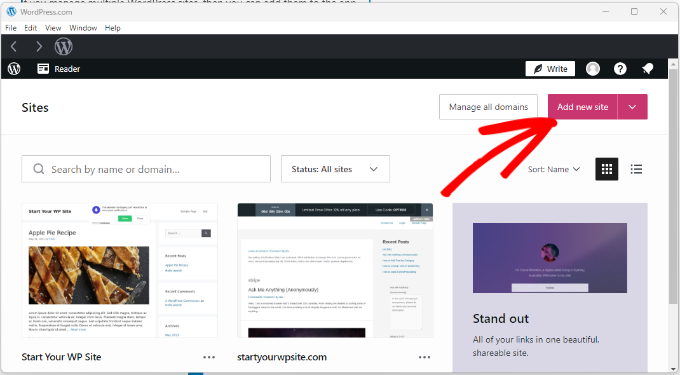
We hope this article helped you learn how to use the WordPress desktop app for your self-hosted website. You may also want to see our list of the must-have WordPress plugins to grow your website and our guide on how to use the WordPress app on your iPhone, iPad, and Android.
If you liked this article, then please subscribe to our YouTube Channel for WordPress video tutorials. You can also find us on Twitter and Facebook.





Olaf
I tried the application after reading this guide, but in the end, I found that it didn’t offer any advantages over working in the admin panel, which is also much more comprehensive. Offline writing is missing, and Jetpack needs to be installed. I just don’t see the benefits that would make me want to use the app. But it was a good experience. Maybe if the developers worked on the details I mentioned above, it would be a great app. As it is, though, it’s just missing the most important aspects.
Oyatogun Oluwaseun Samuel
With all the requirements to use wordpress desktop app it seems to me that there not much edge in using it over actually going to your browser and type in your wordpress admin URL and login to do your chore. For me the desktop app is a no. thanks anyway.
Jiří Vaněk
The app seems to be a good alternative to the mobile app. But its disadvantage for me is the jetpack plugin. I had it on the website for a long time, but in the end it didn’t quite fit with the autoptimize and wp-rocket plugins. So it’s quite a shame that it can’t be done without a jetpack.
Mrteesurez
That’s also need to be addressed by the Community. Maybe there will be a standalone app that will not rely on any external plugin. An app that will be built solely for WordPress core.
But in your case, I think Jetpack also have both optimization and security modules/functionalities, You can just disable those plugins and used Jetpack’s.
Jiří Vaněk
Overall, the Jetpack plugin caused me problems with the current configuration of the website, and for that reason I assume it is unusable for me and for other people. In the end, I solved the problem by writing notes in a text editor so that nothing disturbs me and then I put it into Wordpress. As long as Jetpack is mandatory, the app is unfortunately unusable for me.
Mrteesurez
Although, I have not used WordPress Desktop App on my PC.
But when I used it on mobile, I am able to write post and save it while I’m offline. The post will be saved as draft till I connect to the internet.
Is it only the Desktop App that requires internet connection as you have mentioned in the Pros & Cos.
Also, is there any way I can write a post offline and after posting to WordPress, it will retain all the styles, alignment, heading and links therein.
WPBeginner Support
We do not have an alternative for writing offline like you are wanting at the moment that we would recommend. The closest would be to create a local installation and export the post from the local installation and import it onto your live site. If you wanted to do that then we would recommend taking a look at our article below:
https://www.wpbeginner.com/wp-tutorials/how-to-install-wordpress-on-your-windows-computer-using-wamp/
Admin
Mrteesurez
That would be better I think so, because the post in local area will show almost full potential of the posts and likely to retain those style on a live site.
I think WordPress community will work on that by making it possible to write post while offline on Desktop App. I think this will be possible so far it’s achieved on mobile.
Moinuddin Waheed
Thanks for the detailed article about desktop app for the WordPress self hosted guide.
I have seen people having reservations about jetpack plugin as one need to install and give access to information to wordpress.com
is it safe to use jetpack plugin and anything related to wordpress.com?
WPBeginner Support
WordPress.com is a safe site to be connected to, we would recommend taking a look at our article below that goes over who owns WordPress.com
https://www.wpbeginner.com/beginners-guide/who-owns-wordpress-and-how-does-wordpress-make-money/
Admin
ali
thank you for this valuable information but the problem is when you add a self hosted website and when you try to write post it loads the site in the browser and to let you post from there it word for simple wordpress.com site but never for a self hosted website. is there a way to post from the desktop app in a self hosted website?
WPBeginner Support
For modifications to the app and what is available, you would want to reach out to the support for the app and recommend possible changes and they should be able to help.
Admin
Uzair
First, you should check your site’s permissions and settings. Make sure everything’s up to date—WordPress, themes, and plugins.
Then, dive into the app settings for your site. See if tweaking connection settings helps. You could also try installing the Jetpack plugin; It often helps bridge the gap between self-hosted sites and the app.
If things still aren’t working, clear your browser’s cache and cookies, and also check if the same thing happens when you use a different browser.
And if all else fails, reach out for support.